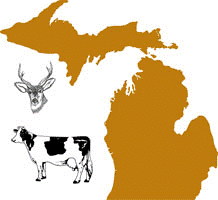Wildlife Disease and Zoonotics
Date of this Version
1999
Abstract
The objective of this study was to develop a suitable experimental model of natural Mycobacterium bovis infection in white-tailed deer (Odocoileus virginianus), describe the distribution and character of tuberculous lesions, and to examine possible routes of disease transmission. In October 1997, 10 mature female white-tailed deer were inoculated by intratonsilar instillation of 2 3 103 (low dose) or 2 3 105 (high dose) colony forming units (CFU) of M. bovis. In January 1998, deer were euthanatized, examined, and tissues were collected 84 to 87 days post inoculation. Possible routes of disease transmission were evaluated by culture of nasal, oral, tonsilar, and rectal swabs at various times during the study. Gross and microscopic lesions consistent with tuberculosis were most commonly seen in medial retropharyngeal lymph nodes and lung in both dosage groups. Other tissues containing tuberculous lesions included tonsil, trachea, liver, and kidney as well as lateral retropharyngeal, mandibular, parotid, tracheobronchial, mediastinal, hepatic, mesenteric, superficial cervical, and iliac lymph nodes. Mycobacterium bovis was isolated from tonsilar swabs from 8 of 9 deer from both dosage groups at least once 14 to 87 days after inoculation. Mycobacterium bovis was isolated from oral swabs 63 and 80 days after inoculation from one of three deer in the low dose group and none of four deer in the high dose group. Similarly, M. bovis was isolated from nasal swabs 80 and 85 days after inoculation in one of three deer from the low dose group and 63 and 80 days after inoculation from two of four deer in the high dose group. Intratonsilar inoculation with M. bovis results in lesions similar to those seen in naturally infected white-tailed deer; therefore, it represents a suitable model of natural infection. These results also indicate that M. bovis persists in tonsilar crypts for prolonged periods and can be shed in saliva and nasal secretions. These infected fluids represent a likely route of disease transmission to other animals or humans.


Comments
Published in Journal of Wildlife Diseases, 35(3), 1999, pp. 450–457.